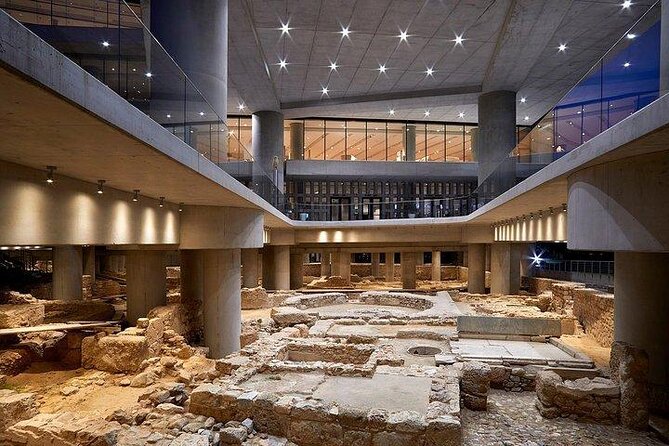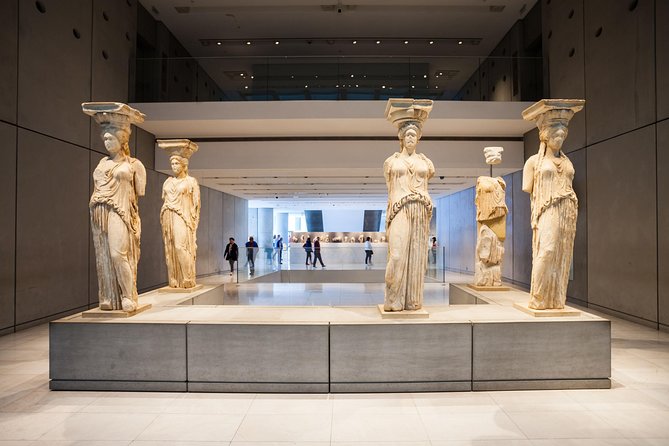An Athenian landmark and feat of contemporary architecture, the Acropolis Museum sits at the base of the Acropolis, with the ruins of an ancient settlement visible through its floor. The collection runs from pre-classical times to the Roman era, but fifth-century BC treasures are the focus, especially the Parthenon Frieze sculptures.
The Basics
Wander the Acropolis Museum (Museo Akropoleos) for a look at original pieces from the temples of the Acropolis, protected from further deterioration and presented with historical context. In the Parthenon Gallery, see the famous marble frieze recreated. View statues that predate the Acropolis itself in Archaic Gallery, and find pots, children’s toys and other things used by the early settlers in Gallery of the Slopes.
In summer and Easter tourist peaks, a skip-the-line ticket saves time. The Acropolis Museum is set up for independent exploration, but it’s also a popular stop on Athens history tours. An Acropolis Museum
Things to Know Before You Go
- The Acropolis Museum is a must for any visitor to Athens.
- Museum facilities include two shops, a cafe, and a restaurant, open late on Fridays.
- Completed in 2007, the Acropolis Museum replaced an older museum of the same name.
- The museum appeals to families, with activity backpacks for kids.
- The Acropolis Museum is fully wheelchair accessible, with accessible bathrooms and elevators. Wheelchairs are available, and service dogs are welcome.
How to Get There
The Acropolis Museum is a 10-minute walk from the Acropolis in downtown Athens, and many travelers combine a visit to the Acropolis with a tour of the museum. Driving in historic Athens is not recommended. Ride the metro to Acropolis (Line 2), catch a bus or a trolley to Makriyianni, take the tram to Leoforos Vouliagmenis, cycle, or go with a tour.
When to Get There
The museum is open daily, with extended hours in summer and cheaper tickets in winter. It is closed on major holidays. Visit midweek for a less crowded experience.
The Parthenon Frieze
The Acropolis Museum’s most famous—and most controversial—display is the Parthenon Frieze, a 525-foot (160-meter) masterpiece by the fifth-century Athenian sculptor Phidias that once crowned the Parthenon temple. The white patches are plaster casts of its missing pieces, the Parthenon Marbles or Elgin Marbles, removed by Lord Elgin in 1801 and now held by London’s British Museum. Watch the film to learn more about the religious procession the frieze depicts.

Acropolis Museum Ticket
Pre-booking skip-the-line tickets to the Acropolis Museum in Athens is a time-saving strategy to take care of planning in advance. With the option to use a mobile or paper ticket, you’ll walk right past long lines for purchasing admission onsite; that ensures even more time to explore thousands of ancient artifacts in the Acropolis Museum.
One of the most important museums in Greece has a total area of 25,000 square meters and includes archaeological treasures dating to pre-historic times. The museum is divided into 4 main galleries and offers the opportunity to the visitor to view archaeological artifacts and learn about the Acropolis site. After crossing the ground floor lobby towards the turn styles of the Museum, the first collection lies before you.
The Gallery of the Slopes of the Acropolis houses finds from the sanctuaries that were founded on the slopes of the Acropolis, as well as objects that Athenians used in everyday life from all historic periods. Continue to the Archaic Acropolis Gallery and view exhibits from all sides as three-dimensional exhibits. With the benefit of the changing natural light, you can discern and discover the delicate surface variations of sculptures and select the vantage point from which to observe the exhibits.
At the final Gallery, you will admire views of unique works that became prototypes for subsequent periods from antiquity to today. For the first time ever, it is possible to view the coffered ceiling of the Propylaia and the sculptures from the parapet of the temple of Athena Nike, and finally, the Caryatids – or Korai of the Erechtheion at close proximity on the balcony overlooking the Gallery of the Slopes of the Acropolis. The main monuments that constitute the Classical Acropolis are the Propylaia, the temple of Athena Nike and the Erechtheion.
The exhibition concludes at the north side of the first floor gallery where you will see numerous statues were placed on the Acropolis, which represented gods, heroes, mythological themes and portraits of famous men including the Sanctuary of Artemis Brauronia.
Acropolis Monuments & Parthenon Walking Tour with Optional Acropolis Museum
The UNESCO-listed Acropolis of Athens is the city’s most visited attraction, but it has the traffic to match. This walking tour starts early to avoid the crowds and includes highlights such as the Parthenon, Erechtheion, and the Acropolis Museum.
Expect Meet your guide in the early morning and walk the short distance to the Acropolis. After picking up your tickets, head inside to explore the hilltop archaeological site. Listen as your guide transports you back to ancient Greece with stories of the ancient city and its importance.
Stop to admire the magnificent ruins, most of which date back to the 5th-century BC, including the much-photographed Parthenon, the restored Temple of Athena Nike, and the Erechtheion, known for its exquisite Caryatid statues. After exploring the ruins, head to the Acropolis Museum to see even more artifacts that highlight the history of ancient Greece. Your tour ends in Monastiraki Square in central Athens.


